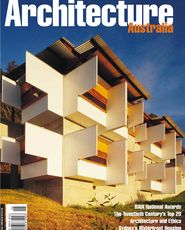|
Waterfront lifestyle is a Sydney obsession, not surprisingly as the harbour gives the most perfect setting that a city could want. Over time it has developed diverse activities and uses with distinctive characters, and a legacy of impressive built forms. Remnants of natural bush and shoreline still give a sense of the place before European settlement. Until recent times the waterfront was for those who used the harbour for work or recreation. Although there were many grand residences, most waterfront houses were modest or even humble. They were often cheaper than comparable properties on the North Shore Line or in green and leafy garden suburbs such as Strathfield and Haberfield, which gave the familiar comfort of a recreated English landscape. But the market has changed radically over the last 25 years and with each property boom, the relative value of waterfrontages and real estate with harbour views (whether actual or promised) has increased strongly. The pressure for new up-market housing is now controlling patterns of development. Massive new apartment projects are proliferating on former industrial sites, changing the character of the harbour. Thankfully governments at all levels, with community support, have responded to this pressure for change by promoting a ‘working harbour’ policy; but balancing this objective against the power of economic forces will be a difficult task. Two crucial examples of these development pressures are King Street Wharf, along the north-eastern side of Darling Harbour, and Jacksons Landing, on the old CSR refinery site at the north-western end of Pyrmont Point. Both are under construction, with the usual sense of urgency. They have similar promotional campaigns, with glossy brochures and demonstration suites, as well as promises of unparalleled amenity, to show prospective purchasers the extraordinary lifestyle on offer ‘off-the-plan’. But is the public realm suffering at the expense of private interest? Jacksons LandingThe CSR site dominated Pyrmont. It was a large waterfront holding with massive industrial and wharf structures. While the Pyrmont/Ultimo masterplan was being developed in the early nineties, the CSR site fell into the very hard basket. This is not surprising as the almost 12 hectare site had a varied and rocky topography, remains of many impressive industrial structures, an erratic street pattern and severe remediation problems.
The Lend Lease Corporation, which purchased the site from CSR, is one of Australia’s most enlightened developers. Its collaborations with Mirvac and a variety of architects at the Olympic Village, Newington, and with Renzo Piano in Macquarie Street, are producing impressive results. One would have expected an equally significant outcome at Pyrmont. The site was so large that the owners and developers had a significant input in the planning process, controlled through the Department of Urban Affairs and Planning (DUAP). The result is an odd contrast between the general character of the Pyrmont peninsula and that of a new ‘Jacksons Landing’. Even the name and marketing image accentuate this difference, with Jacksons Landing described as “a new waterfront village” and its location at the end of Pyrmont barely mentioned; it is intended to be perceived as a separate community from the adjacent suburb. The Jacksons masterplan retains the requisite heritage items, but renders them somewhat meaningless by removing most of their context. Indeed, one senses that heritage has become a lever to develop the maximum envelope along the waterfront. The facade of the sober old 10-storey sugar refining building has been retained, but has new ends and two extra storeys above to create a lifestyle apartment slab. This ‘heritage’ envelope has then been used to justify a series of brand new apartment blocks, up to 14 storeys tall, producing a wall of building along the shoreline. This is uncharacteristic of the area and the harbour generally. The old refinery facade, adapted by Jackson Dyke, retains its robust form, but the new apartment blocks, built to the Moore Ruble Yudell masterplan, are distinguished by curious roof forms and an over-abundance of thin balconies and glass infill. The wall of apartments so overwhelms the rest of the development that other built forms such as the intelligent new adaptations of the terrace type, by Richard Huxley and Peter Tonkin, cannot achieve their potential. The terraces draw on the grain and scale of earlier subdivision patterns while achieving surprisingly high densities through clever parking and courtyard arrangements. But they are dominated by the neighbouring tall buildings, which separate them from the water. The new, publicly accessible, waterfront and park lands are similarly overwhelmed and may end up as quasi-private space rather than part of the public realm. King Street WharfThis is a chapter of the classic Sydney story, like a game of musical chairs but one in which everyone appears to be a winner (but does the public good and the city’s future really win?) The growing charter boat industry, concerned about losing access to critical wharf space around other parts of the harbour, where they were pushed out by new developments, approached the Minister for Ports to examine development of the then overseas passenger terminal. This structure was only a few years old – built to replace the passenger berth at Pyrmont which had become the temporary (now redundant) casino. At first sight, this is not a bad idea: it could create vibrant and active uses on the waterfront and perhaps generate some of the energy that is felt at Circular Quay with its mix of commuters, tourists, entertainers and passers-by. However the current project for this huge site is so hurried and has become so quantity-oriented, that the quality potentials are unlikely to be realised. The western side of the city has undergone rapid but disjointed change over the last two decades. There are good lessons to be learnt from similar ad-hoc processes near the King Street Wharf site. The ill-considered road engineering of the Western Distributor created a powerful barrier between the city and the harbour (much more than the Cahill Expressway at Circular Quay). The only way to connect across the chasm was by bridge and underpass and a strange assortment of crossings has evolved over the years. The most bizarre is the one attached to the stylish world of Cockle Bay Wharf and the only one of real merit is Buzacott Caro’s bridge at the western end of King Street. The freeway system flying over Darling Harbour has left a continuing problem of connection to the city and Ultimo and has isolated the magnificent old Pyrmont bridge. The Aquarium adjacent to the King Street Wharf site was intended to terminate the Darling Harbour precinct at its northern end. Planned on the assumption that it was the conclusion of the public waterfront experience, it turned its back on the wharves to the north. The consequences of these and similar ad-hoc decisions should have acted as a sobering lesson in the planning of any new development along the western edge of the CBD: if nothing else that the process should not be rushed, but should be guided by a vision of the potential for long-term development of a vast tract of public waterfront land. It is disappointing that the first section has once again been considered in isolation. Jacksons Landing KeyThe Jackson Teece Chesterman Willis urban design strategy for the King Street Wharf scheme is simplistic: it takes the alignments of King and Erskine Streets and extends them down across the wide wharf apron. These are then connected by link roads parallel to Sussex Street to replicate a city block structure. New cruise boat and ferry berths will be constructed along the waterfront, and a series of retail/commercial buildings will line the shore: behind them are placed a set of three apartment buildings of low and bulky proportion.
At least this is an active waterfront for a working harbour, but the masterplan is hurried and diagrammatic, with predictable street patterns, building heights and uses. Unfortunately, when it has been tested with real building forms by developer Multiplex and joint architects Crone and Cox Richardson, the weaknesses have become apparent. The residential buildings have deep plan forms, requiring a strange distortion of the western facades to achieve the ‘vital’ harbour views. Ironically, although the project is being marketed for its waterfront lifestyle and views, (with a demonstration unit built on the harbour’s edge) most of the apartments look straight into the commercial buildings to the west or to the wall of city buildings and freeway to the east. The deep plan also requires anonymous internal corridors, precluding effective cross-ventilation. The charter boats will generate a large amount of tourist coach traffic. This will surely impact on the residential amenity of the area and create a ‘tourist-trap’ atmosphere in the public realm. The whole site, although modelled on a city block structure, is only accessible to pedestrians from King and Erskine Streets or via a circuitous route through the Aquarium complex. Access from the north is blocked by the latest version of the overseas passenger terminal. It is hard to see how this new area will become a vibrant part of the city. The State Government, as proponent of the project, has taken the simple way out of administration by handing the development over to a single design-construct consortium,reducing the possibility of genuine diversity and giving effective control of the public realm to private interests. The final irony is that the developers would like to remove Buzacott Caro’s footbridge – the city’s newest and best – and replace it with a road overpass and a freeway-influenced junction at the intersection of Sussex and King Streets, to facilitate tourist bus movement. Although this might make some sense, the irony is palpable as pieces move faster in this urban game than on a Monopoly board. Both these projects demonstrate the problems of urbanism skewed towards profit, where the quality of the public realm, the essential characteristic of all great cities, is compromised by the industry’s economic imperatives. This is particularly true when the expectations of density and financial return, or pressure from Government to deliver a windfall return to Treasury, boost land values while creating a continuing pressure to increase the developers’ yield. It is likely that both projects will enjoy commercial success. If so, the developers would have done their job well on behalf of their shareholders. But from the public and civic perspective, we should question whether the processes which generate often undistinguished architecture and urbanism are the best we can do, or whether there are better models to create long-term public benefit. It is sobering to reflect upon Oriel Bohigas’ words in accepting the RIBA Gold Medal, when he presented 10 points for an urban methodology – including the idea that “public space is the city” and an argument for the importance of “the architectural project versus general plans.” Perhaps we should develop a culture of critically testing, refining and evaluating our urban propositions before rushing to implementation. |
Source

Archive
Published online: 1 Nov 1999
Words:
Paul Berkemeier
Issue
Architecture Australia, November 1999


















